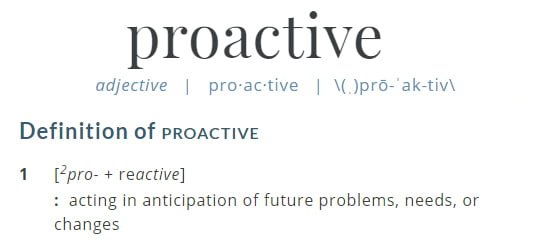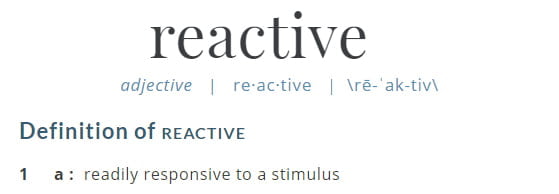
Here we go again: Another article on proactivity.
We get it: We’re not the first to stress the importance of being proactive. In fact, it’s become so common it’s almost a buzzword amongst founders and entrepreneurs; something people say to sound impressive or “in touch,” but not something they necessarily act upon or even understand.
Sure, they’re happy to tout its importance … But can they tell you what proactivity means? Can they actually tell you how to be proactive? In our experience, the answer is no.
And that’s a huge problem.
By turning proactivity into a buzzword, we’ve cheapened it. It’s become like white noise; something you hear but tune out.
It’s time to add clarity and turn up the volume, because here’s the truth: Proactivity is a vital part of creating massive success, and it’s the only way to reach your full potential.
So let’s get to the heart of it: What is proactivity, and how can you become a more proactive person?
What is Proactivity, Anyway?
Let’s start off simple: What does it mean to be proactive? According to Merriam-Webster, it means, “acting in anticipation of future problems, needs, or changes.”

Put differently, being proactive means completing carefully-planned actions to achieve the goals that move the needle most for your business. It means focusing on what’s important, not just what’s urgent.
Sounds like a good idea, right? The problem is, our world is becoming increasingly reactive, not proactive. According to Merriam-Webster, a reactive person is someone who is, “readily responsive to a stimulus.”

In other words, a reactive person is at the mercy of urgency and outside influence. Because the feeling of urgency often trumps the feeling of importance, many of us spend our days stuck in an endless loop of:
- New email? Better respond right away.
- Meeting request? Can’t say no to that.
- Slack notification? Better respond before it’s lost in the endless stream of messages.
Then, at the end of the day, we wonder where our time went.
What makes reactivity so dangerous is that it feels productive. After all, you just responded to 53 emails, right? Sure, but there’s a world of difference between “getting stuff done” and actually making progress.
Think of it this way: A proactive person is like a stallion and a reactive person like a rocking horse. Both are moving, but only one is moving forward. Who do you think wins the race?
You guessed it: Proactivity always outperforms reactivity. You’ll see why soon, but first let’s take a practical look at proactive tasks.
What Does Proactivity Look Like?
Alright, we know what proactivity is. The next question is, what does it look like?
After all, reactive tasks are pretty obvious; they’re the urgent day-to-day time sinks most people do out of habit. And it’s not that reactive tasks don’t need to be done; it’s that they don’t have to be done in the moment, and they don’t necessarily have to be done by you.
Proactive tasks, on the other hand, take more thought and involvement. They’re the projects that move the needle most for your business; the great ideas you’ve been putting off until you “have more time.” For example:
- Developing strategic goals to make the upcoming year successful and productive,
- Creating a compelling list of reasons why a specific feature is important for your product in order to move the company in that direction, or
- Writing a blog post to develop thought leadership in your market.
In short: Proactive tasks are the strategic initiatives that move you dramatically closer to turning your goals into reality.
If you want to learn more about how you can proactively reach your goals, check out our article: A Success Guide to Scaling Yourself (While Scaling Your Business).
Embracing Proactivity: The Most Important Trait of Proactive People
So what does it take to be proactive? In a word, discipline.
Here’s why self-discipline is so important: The moment you start incorporating proactivity into your life, the world will test your resolve. Emergencies will arise, demands will increase, and you’ll be tempted to fall back into unproductive, reactive behaviors.
To stay proactive in a reactive world, you need unyielding self-discipline; because you can’t always control your circumstances, but you can control your response. You can choose to remain proactive.
Because in the end, success isn’t the result of circumstance; it’s the result of response to circumstance [Tweet this!]. And that’s the heart of self-discipline.
Here are the three best things you can do to bolster your self-discipline today.
1. Create a Compelling Reason to Stay Disciplined
When reactive temptations arise, you’ll need a reason to remain disciplined. You could try to white-knuckle it, but you can only do that for so long before you wear out your resolve.
You’re much more likely to stay disciplined if you have a compelling reason to do so; a clear and motivating picture of what you’re working towards. That’s where goals come in.
According to research by Harvard (and that of many others), “ … individuals with clear, written goals are significantly more likely to succeed than those without clearly defined goals.”
Think of it this way: If you wanted to travel somewhere new, what’s the first thing you’d do? Probably find it on a map. Then, once you knew where you were heading, you’d develop a plan to get there. And only once you’d done that would you actually start traveling.
In the face of distraction and temptation, goals are a vital tool to stay proactive, disciplined, and on-track to success.
For more on effective goal creation, check out Stop Setting Weak Goals: The Ultimate Guide to Creating Goals (That Actually Get Done).
2. Eliminate Procrastination
Procrastination creates pressure, pressure creates stress, and stress severely limits your brain’s creative processing powers.
As we’ve already discussed, creativity is a vital aspect of proactivity; so it’s not a stretch to say that when you procrastinate, you render yourself incapable of being fully proactive.
For the sake of your productivity, here are five steps to channel self-discipline and beat procrastination. According to Harvard Business Review:
- Vividly imagine how it’ll feel to complete the task you’re putting off,
- Visualize the consequences of failing to complete that task,
- Publically commit to completing it by a clear deadline,
- Identify the first step to get started, and
- Reward yourself for completing the first step.
Once you’ve taken that first step, the momentum and follow-through often take care of themselves.
3. Say No
At any point, there are near-endless demands on your time. From emails to Zoom calls to meetings, someone always needs a “quick” 15 minutes from you.
But those “quick” requests add up fast, and it doesn’t take much for a month to pass before you realize you’ve been entrenched in reactivity and haven’t made any real progress.
It’s time to take back control of your time, and that starts by saying “No.”
Next time you get a request for your time, ask yourself: “Is this aligned with what I’ve decided to proactively work on this week?” If the answer’s no, your response should probably be no.
Not sure how to turn the other person down? Afraid of hurting their feelings? A study by the Journal of Consumer Research found that simply changing your wording can change negative associations to the rejection, both for you and the person being rejected.
Here’s how it works: Instead of saying “I can’t … ” or “I won’t … ”, which are perceived as negative and personal, say, “I don’t …” which is more general and sets a precedent for future requests.
With this approach, you aren’t rejecting the person, you’re rejecting the event. For example:
- I don’t respond to emails after 8:00PM,
- I don’t meet outside of the office, or
- I don’t reply to Slack messages over the weekend.
An added bonus: When you make an “I don’t” statement, you set a rule. As people become familiar with that rule, you’ll face fewer similar demands in the future.
Need more ideas? Try one of these 4 ways to say no to endless requests for your time.
Incorporating Proactivity into Your Life
Alright, you know what proactivity is, you know what it looks like, you know why it’s important, and you know how to protect it with self-discipline.
And we think you’ll agree: When you take all the hype and buzz out, you’re left with a very simple concept: Being proactive means investing in your future.
So here’s the question: Are you 100% happy with the present? Have you completed all you set out to do? Is your bucket list empty? Or do you feel there’s still more success to be experienced?
Let us share a secret with you: There is. No matter how good things are now, there’s always the potential for something even greater. And that future can be yours, if you’re willing to invest in it.
This is just the beginning: To learn how to incorporate proactivity into your daily life (a topic important enough to warrant an in-depth article all it’s own), check out Whitespace Time Management: The Proactive Entrepreneur’s Guide to Owning Your Time and Mastering Your Priorities.


